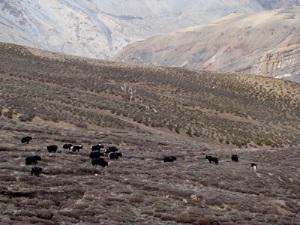Kulbhushansingh Suryawanshi
The aim of the project is to understand the foraging behaviour of snow leopard in relation to availability of wild-prey and livestock. We will correlated snow leopard diet to different ratios of livestock to wild-herbivore abundance to identify factors affecting snow leopards livestock depredation behaviour.

A snow leopard peeps out of his day time resting hideout.
Globally, conservationists are facing the tough task of mitigating human-wildlife conflict. Livestock depredation by large carnivores is a serious problem faced by carnivore conservationists across the world. Intense conflict between snow leopards (Unica uncia) and pastoralists threatens the survival of this endangered carnivore. About 3 to 12% livestock holding is lost to snow leopards and wolves annually (Oli 1994; Mishra 1997; Jackson and Wangchuk 2004; Namgail et al. 2007). The species is thus persecuted by local communities throughout its distribution range (Mishra et al. 2003; Bagchi and Mishra 2006). Given this reality, is sustained co-existence of snow leopard and pastoralism possible?

Detailed understanding of carnivore behaviour is necessary to reconcile and mitigate conflict. The role of wild-prey availability in a carnivore's foraging decision making has often been ignored when trying to understand their livestock depredation behaviour. Clearly, for a snow leopard, the cost benefits of killing a wild-prey differ from killing livestock. With this background, I propose to identify factors affecting snow leopard foraging decisions with special emphasis on livestock depredation. While snow leopards will take a livestock opportunistically, I intend to explore the thresholds in their decision making where livestock killing becomes a part of snow leopard foraging strategy and not merely a consequence of opportunity. I will examine the contribution of wild-prey and livestock to snow leopard diet in areas with different ratios of wild-prey and livestock availability and assess how snow leopard diet changes along a gradient of wild-prey to livestock availability.